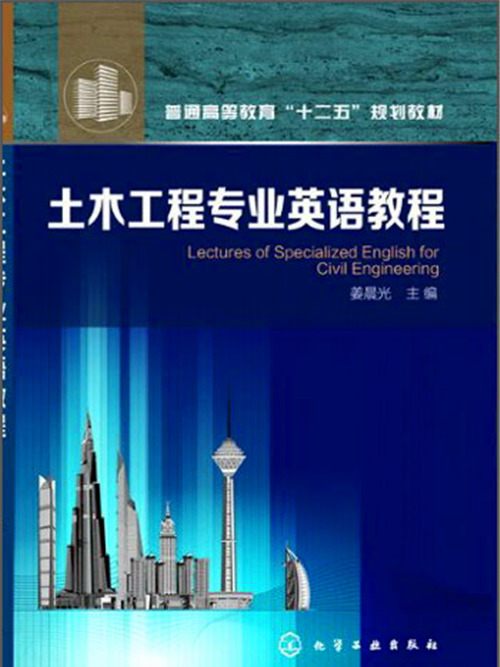內容簡介
《普通高等教育“十二五”規劃教材:土木工程專業英語教程》以目前世界科技界對當代土木工程科學的主流認識為依據,從巨觀的角度出發,全面地介紹了土木工程科學的概貌,對讀者了解土木工程科學具有一定的啟蒙作用,對大土木工程行業各專業學生了解當代土木工程題材英文文獻著作的寫作特點具有一定的積極作用。《普通高等教育“十二五”規劃教材:土木工程專業英語教程》的英文部分全部出自英、美土木工程科學家之手(是原汁原味的英語),全書的內容涵蓋了Materials Engineering(材料工程學)、Geotechnical Engineering(岩土工程學)、Structural Engineering(
結構工程學)、Surveying Engineering(
測量工程學)、Construction(建築施工學)、 Transportation Engineering(
交通工程學)、Hydraulic Engineering(水利工程學)、Environmental Engineering(環境工程學)8大土木工程類學科。本教材適合作為我國
普通高等教育土木工程、工程管理、測繪工程、交通工程、水利水電工程、
環境科學與工程、
地理信息科學、地理科學、遙感科學與技術、房地產開發與管理、工程造價、城市管理、
城市地下空間工程、
道路橋樑與渡河工程、水務工程、導航工程、
地理國情監測等專業的專業英語教材,也可作為相關專業的英文版《土木工程概論》雙語教材使用,還可供我國大土木工程行業人員閱讀、寫作英文專業資料時作為參考。
圖書目錄
1 Materials Engineering (材料工程學)
1.1 Introduction
1.2 Wood as a Construction Material
1.3 Structural Steel
1.4 Constituents and Properties of Concrete
1.5 Durability of Concrete
1.6 Special Concrete and Application
1.7 Bituminous Materials and Mixtures
Problems
References
2 Geotechnical Engineering (岩土工程學)
2.1 Introduction
2.2 Soil Relationships and Classification
2.3 Strength and Deformation
2.4 Stress Distribution
2.5 Accounting for Variability
2.6 Groundwater and Seepage
2.7 Consolidation and Settlement Analysis
2.8 Stability of Slopes
2.9 Geosynthetics
2.10 Foundations
2.11 Retaining Structures
2.12 In Situ Subsurface Characterization
2.13 In Situ Testing and Field Instrumentation
2.14 Geotechnical Earthquake Engineering
2.15 Geo-Environment
Problems
References
3 Structural Engineering (
結構工程學)
3.1 Introduction
3.2 Mechanics of Materials
3.3 Theory and Analysis of Structures
3.4 Structural Reliability
3.5 Structural Concrete Design
3.6 Design of Steel Structures
3.7 Cold Formed Steel Structures
3.8 Composite Steel-Concrete Structures
Problems
References
4 Surveying Engineering (
測量工程學)
4.1 Introduction
4.2 General Mathematical and Physical Concepts
4.3 Geodesy
4.4 Plane Surveying
4.5 Geographic Information Systems
4.6 Photogrammetry and Remote Sensing
Problems
References
5 Construction (建築施工學)
5.1 Introduction
5.2 Construction Planning and Scheduling
5.3 Equipment Productivity
5.4 Design and Construction of Concrete Formwork
5.5 Construction Automation
5.6 Contracts and Claims
5.7 Construction Estimating
5.8 Value Improvement Methods
Problems
References
6 Transportation Engineering (
交通工程學)
6.1 Introduction
6.2 Transportation Planning
6.3 Environmental Considerations during Transportation Planning
6.4 High-Speed Ground Transportation:Planning and Design Issues
6.5 Geometric Design
6.6 Urban Transit
6.7 Airport Planning and Design
6.8 Highway and Airport Pavement Design
6.9 Highway Traffic Operations
6.10 Intelligent Transportation Systems
6.11 Highway Asset Management
Problems
References
7 Hydraulic Engineering (水利工程學)
7.1 Introduction
7.2 Fundamentals of Hydraulics
7.3 Surface Water Hydrology
7.4 Open Channel Hydraulics
7.5 Sediment Transport in Open Channels
7.6 Coastal Engineering
7.7 Groundwater Engineering
7.8 Simulation in Hydraulics and Hydrology
7.9 Water Resources Planning and Management
7.10 Hydraulic Structures
7.11 Urban Drainage
7.12 Quality of Urban Runoff
Problems
References
8 Environmental Engineering (環境工程學)
8.1 Introduction
8.2 Air Pollution
8.3 Incinerators
8.4 Solid Waste / Landfills
8.5 Water and Wastewater Planning
8.6 Biological Wastewater Treatment Processes
8.7 Physical Water and Wastewater Treatment Processes
8.8 Chemical Water and Wastewater Treatment Processes
Problems
References
Appendix Glossary (英漢土木工程常用辭彙)

